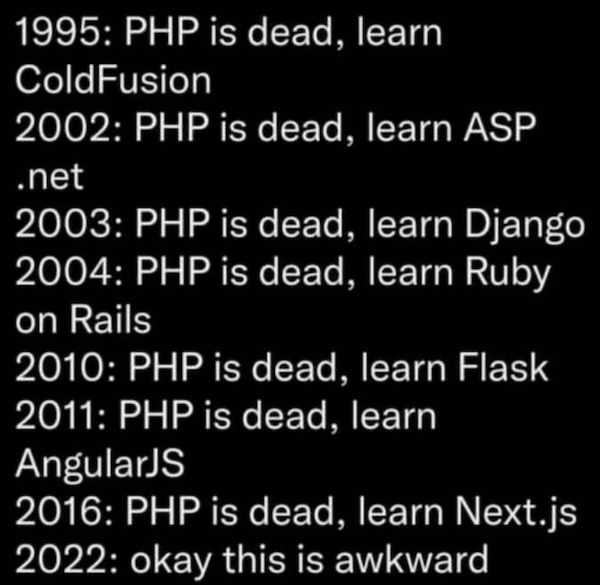 The other day I was mindlessly scrolling Facebook when I came across this meme posted in an IT Humor group. I'm not trying to get into a discussion about PHP, we all know everyone has their favorite language, and to them, it's better than anything else out there. I also understand that most of the time our preferred language is a by-product of what we first started with and honed our programming skills in as we learned or what language just happens to "make sense" to us. I am sure we can all have a good laugh at the meme, however, it was a reminder of how clueless most developers are to modern ColdFusion. What I find humorous is that I have heard "ColdFusion? Isn't that dead" more than I have ever heard anyone imply PHP is dead. Most who develop in ColdFusion have come across these opinions more than once. When ColdFusion was mentioned in the comments they were usually along the lines of "ColdFusion, wow." with replies to that like "thankfully, Coldfusion really is dead", and of course the obligatory "What is cold fusion?" It always seems to be an uphill battle to get people to spend 5 minutes taking a look at what modern ColdFusion really is and the power that comes with it. Most nay-sayers seem to be stuck with this pre-java, early ColdFusion, image and assume that's what it still is. Don't get me wrong, I was using ColdFusion back in those pre-java days and for its time it was still awesome.
The other day I was mindlessly scrolling Facebook when I came across this meme posted in an IT Humor group. I'm not trying to get into a discussion about PHP, we all know everyone has their favorite language, and to them, it's better than anything else out there. I also understand that most of the time our preferred language is a by-product of what we first started with and honed our programming skills in as we learned or what language just happens to "make sense" to us. I am sure we can all have a good laugh at the meme, however, it was a reminder of how clueless most developers are to modern ColdFusion. What I find humorous is that I have heard "ColdFusion? Isn't that dead" more than I have ever heard anyone imply PHP is dead. Most who develop in ColdFusion have come across these opinions more than once. When ColdFusion was mentioned in the comments they were usually along the lines of "ColdFusion, wow." with replies to that like "thankfully, Coldfusion really is dead", and of course the obligatory "What is cold fusion?" It always seems to be an uphill battle to get people to spend 5 minutes taking a look at what modern ColdFusion really is and the power that comes with it. Most nay-sayers seem to be stuck with this pre-java, early ColdFusion, image and assume that's what it still is. Don't get me wrong, I was using ColdFusion back in those pre-java days and for its time it was still awesome.
For anyone interested in a 3-4 minute read that might give you a better understanding of ColdFusion and the power of modern ColdFusion I submit the following for your consideration:
What is ColdFusion?
Adobe ColdFusion is a server-side scripting language that has been around since the late 1990s. While some people believe that ColdFusion is dead or outdated, today it is a modern and versatile development platform running on Java that continues to be used by businesses of all sizes. We will explore why Adobe ColdFusion is very much alive and highlight a few of the top reasons to use it.
A Brief History of ColdFusion
ColdFusion was first created by JJ Allaire and Jeremy Allaire of Allaire Corporation in 1995. The idea behind ColdFusion was to provide a language that could seamlessly connect HTML pages to databases. This made it possible to create dynamic, data-driven websites without having to write a lot of complicated code. ColdFusion first began as a completely tag-based language allowing those familiar with HTML to learn ColdFusion fairly easily. It has since (and for quite a while now) evolved into a scripting and tag-based language allowing for easy and seamless integration into HTML. With CFScript (ColdFusion Script ) and CFML (ColdFusion Markup Language), the versatility is astounding.
As ColdFusion gained popularity it was acquired by Macromedia in 2001. It was in 2002 that Macromedia released version 6.0, ColdFusion MX. Version 6 was reworked from the ground up and was based on the Java EE platform. This shift to Java opened the doors to eventually run on Mac OS starting with version 7.0.1 and Linux starting with version 8.
Macromedia was acquired by Adobe Systems in 2005, and ColdFusion became an official Adobe product ever since.
Today ColdFusion is a mature, stable, and enterprise-level platform that is used by businesses and organizations around the world. It is continually updated, improved, and modernized with each new release.
Top Reasons to Use Adobe ColdFusion
- Rapid Application Development (RAD)
ColdFusion allows developers to create complex applications quickly and easily. This makes it possible to create applications much faster than with other languages. - Versatility
ColdFusion is a versatile language that can be used for a wide variety of applications, including web development, mobile app development, and enterprise applications. Because it runs on top of Java, its integration with Java is quick, easy, and powerful. It can also be integrated with other technologies, such as .NET making it a powerful tool for creating complex, multi-tiered applications. - Security
ColdFusion's strong security model includes among other features, built-in protection against common security threats, such as SQL injection and cross-site scripting (XSS) which makes it a great choice for applications that handle sensitive data. - Scalability
ColdFusion can handle high levels of traffic and scale up or down on demand. It is a great option for applications that need to handle large amounts of traffic or that need high availability. - Community
The ColdFusion community is active and supportive, with many resources available for learning and troubleshooting. This includes official documentation, forums, and user groups. - Open Source and Free CFScript/CFML Options
For more than a decade there have been Open Source options to utilize almost all of the features of ColdFusion through projects such as Lucee
ColdFusion continues, after 28 years, to be a modern development platform that is continually evolving, improving, and being used by businesses of all sizes. With its rapid application development, versatility, security, scalability, and active community, ColdFusion is a great choice for a wide variety of applications.
For anyone interested in learning more about ColdFusion here are a few links to check out:




Comments
Write A Comment